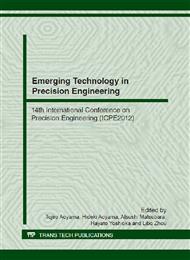p.34
p.40
p.46
p.50
p.54
p.58
p.64
p.70
p.76
Generation of Regularly Aligned Curved Surface Patches on Free-Form Surface for Patch Division Milling
Abstract:
This study describes a new machining strategy to make regularly aligned cutter marks on free-form surface efficiently for increasing the added value of industrial product. While the free-form surface is divided into many small patch segments employing curved surface patch division milling technique which can substitute for the conventional method, thus avoiding the influence of the change in the curvature. And the patch segments will be machined by a spiral tool path respectively, so that regularly aligned cutter marks can be successfully formed on the curved surface patches by controlling cross-feed, feed speed per tooth, number of teeth and the length of the tool path. Comparing the machined surface and the simulation result, the cutter marks agree with it. If the surface is machined only by the ball end milling with a machining center, this method will be a very effective tool for the machinery industry.
Info:
Periodical:
Pages:
54-57
Citation:
Online since:
November 2012
Authors:
Keywords:
Price:
Сopyright:
© 2012 Trans Tech Publications Ltd. All Rights Reserved
Share:
Citation:


